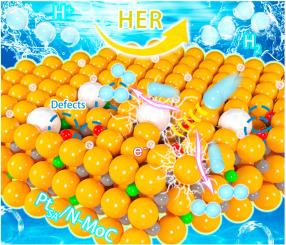mo2c约束Pt单原子中双向h溢出促进的高速率氢电催化
IF 14.2
1区 材料科学
Q1 ENGINEERING, MULTIDISCIPLINARY
引用次数: 0
摘要
设计经济可行且有效的铂基析氢反应单原子电催化剂对实现清洁氢能源基础设施至关重要,但由于缺乏对克服动力学不利的氢溢出的足够认识而受到阻碍。在此,我们将铂单原子限制在氮掺杂MoC纳米片(MoC- nns)的晶格中,以激活双氢溢出效应,并概述了电子金属-支撑相互作用和溢出动力学之间的设计准则。受约束的Pt单原子导致MoC-NNs局部晶格畸变,并产生Mo-O配位,导致Pt单原子和MoC-NNs上的电子结构同时被操纵。因此,PtSA/MoC-NNs表现出出色的HER性能,其质量活性比商用Pt/C高70倍。DFT计算表明,HER性能的增强源于Pt单原子和MoC-NNs之间的电荷离域,这降低了mo到Pt的氢迁移势垒,随后激活了mo到mo的氢在载体上的溢出。此外,Pt (εd-Pt)和载体(εd-support) d带中心的差异(Δεd)可以作为设计动力学高效的Pt基单原子HER电催化剂的描述符。本文章由计算机程序翻译,如有差异,请以英文原文为准。

Bidirectional H-spillover promotion in Mo2C-confined Pt single-atoms for high-rate hydrogen electrocatalysis
The design of economically feasible and effective platinum (Pt)-based single-atom electrocatalysts for hydrogen evolution reaction (HER) is critical to the realization of a clean hydrogen energy infrastructure but is hindered by a lack of sufficient understanding to overcome kinetically adverse hydrogen spillover. Herein, we confine Pt single atoms into the lattice of nitrogen-doped MoC nano-sheets (MoC-NNs) to activate the dual hydrogen spillover effect and outline the design guidelines between electronic metal-support interaction and spillover kinetics. Constrained Pt single-atom causes MoC-NNs local lattice distortion and gives rise to the emergence of Mo–O coordination, resulting in simultaneous manipulation of electronic structure on Pt single atom and MoC-NNs. Thus, PtSA/MoC-NNs exhibited outstanding HER performance with a 70-fold higher mass activity than commercial Pt/C. DFT calculations revealed that the enhanced HER performance originated from the charge delocalization between the Pt single-atom and MoC-NNs, which reduced the Mo-to-Pt hydrogen migration barrier and subsequently activated the Mo-to-Mo hydrogen spillover on the support. Furthermore, it suggests that the difference (Δεd) between the d-band center of Pt (εd-Pt) and support (εd-support) can serve as a descriptor for designing kinetically efficient Pt-based single-atom HER electrocatalysts.
求助全文
通过发布文献求助,成功后即可免费获取论文全文。
去求助
来源期刊

Composites Part B: Engineering
工程技术-材料科学:复合
CiteScore
24.40
自引率
11.50%
发文量
784
审稿时长
21 days
期刊介绍:
Composites Part B: Engineering is a journal that publishes impactful research of high quality on composite materials. This research is supported by fundamental mechanics and materials science and engineering approaches. The targeted research can cover a wide range of length scales, ranging from nano to micro and meso, and even to the full product and structure level. The journal specifically focuses on engineering applications that involve high performance composites. These applications can range from low volume and high cost to high volume and low cost composite development.
The main goal of the journal is to provide a platform for the prompt publication of original and high quality research. The emphasis is on design, development, modeling, validation, and manufacturing of engineering details and concepts. The journal welcomes both basic research papers and proposals for review articles. Authors are encouraged to address challenges across various application areas. These areas include, but are not limited to, aerospace, automotive, and other surface transportation. The journal also covers energy-related applications, with a focus on renewable energy. Other application areas include infrastructure, off-shore and maritime projects, health care technology, and recreational products.
 求助内容:
求助内容: 应助结果提醒方式:
应助结果提醒方式:


